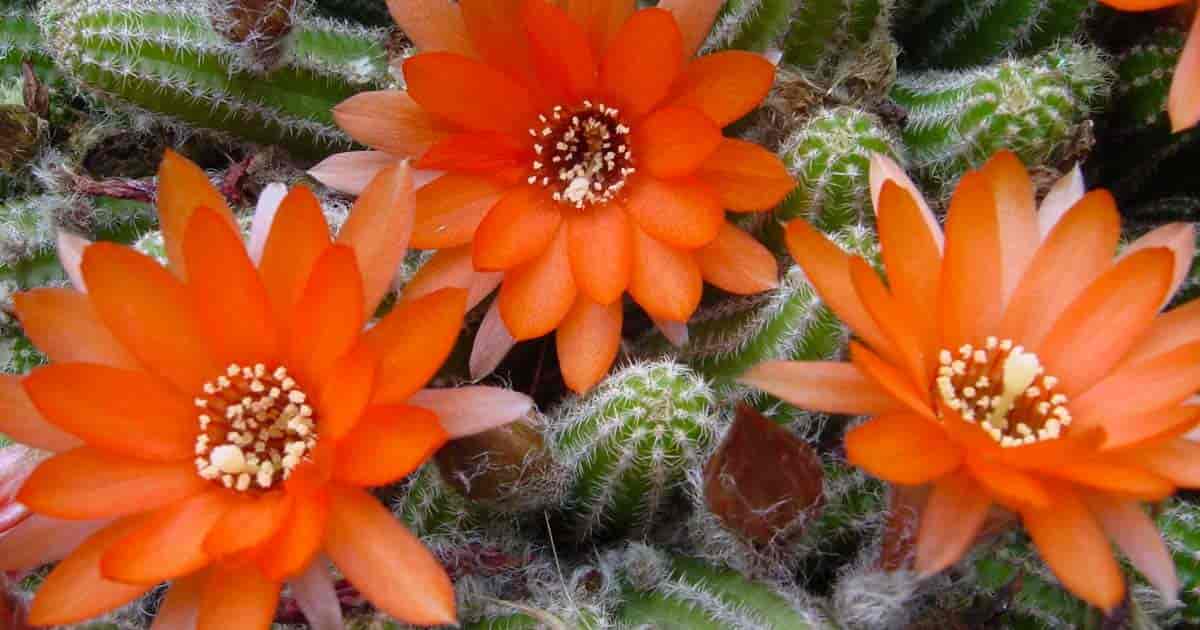Chamaecereus sylvertri [kam-ay-KER-ee-us, sil-VURT-ree] (Echinopsis chamaecereus) is an interesting cactus natively found around bushes and rocks in the mountains of Argentina.
The common name “peanut cactus” comes from the long, creeping cactus stems resembling a pile of fuzzy peanuts.

Echinopsis chamaecereus is a low-growing plant with bright orange or red flowers, making it a popular houseplant or addition to a cacti garden.
Echinopsis chamaecereus formerly known as Chamecereus sylvertri or Chamaecereus silvestrii.
It belongs to the echinopsis genus (more on Echinopsis Urchin Cactus care) and often gets confused with the echinopsis silvestrii.
Both plants are part of the Cactaceae family, which includes 1750 different species of cacti.
Peanut Cactus Care
Size and Growth
The Echinopsis chamaecereus is a low-growing cactus producing multiple creeping stems.
The individual stems are typically about a half-inch thick and may reach up to 6” inches long.
Compared to other cacti, the stems grow relatively quickly.
When fully mature, the stems form a large cluster, creating the appearance which gives it the common name “peanut cactus.”

Flowering and Fragrance
The plant blooms in the spring with blood-red or orange, unscented flowers, a little over an inch in diameter.
During the day, the flowers open. At night, they close back up.
Unfortunately, the flowers of Echinopsis chamaecereus only last about one week and don’t always appear.
- The peanut cactus requires special care to encourage flowering the following growing season.
- When nighttime temperatures drop to just above freezing, bring the plant indoors for the winter.
- Keep the plant in a light, cool area for most of the colder months.
- During this period, the plant only needs water about once per month.
- At the end of winter, move the plant to a slightly warmer spot.
- Slowly introducing warmer and brighter conditions helps prevent any unnecessary stress.
- Before the buds appear, move the peanut cactus to its home for the rest of the bloom.
- After flowering, any movement or sudden changes in temperature may cause the buds to drop off.
- In spring, start increasing the watering.
- After the flowers start to wither, move the plant outdoors or near a window.
Light and Temperature
The plant is winter hardy in USDA zones 10 to 12. In most of North America or Europe, the plant needs to overwinter indoors.
It can thrive indoors at normal room temperature when given enough light. In fact, it needs as much light as it can get.
In the summer, ensure the plant has full sun, especially after the flowering season.
Watering and Feeding
Keep the soil relatively dry during the winter months. It may only need water once per month.
At the start of spring, begin increasing the frequency of watering. Make sure the pot has a drainage hole.
By summer, water the plant frequently but don’t let the soil become completely saturated.
Allow the soil to mostly dry between watering and avoid pouring water directly in the center of the plant.
From April to August, add liquid fertilizer when watering the peanut cactus.
Soil and Transplanting
Use a commercial cactus potting mix for optimal conditions.
An alternative option is to use an equal combination of regular potting soil and perlite or pumice.
Transplant the plant every two to three years after the flowering season.
Repot in damp soil with good drainage.
Grooming
The peanut cactus doesn’t need grooming.
Other Echinocercus Cactus include:
- Hedgehog Cactus
- Echinopsis mamillosa – (Bolivia cactus)
How to Propagate Echinopsis Chamaecereus
Propagate the chamaecereus sylvertri using the stems of the parent plant.
Toward the end of the fall season, when flowering is over, remove one or more of the small “fingers” growing from the base of the plant.
The individual stems root easily in commercial cactus soil.
Place each cutting in its own pot and shade from direct sunlight.
Water sparingly, adding just enough moisture to keep the soil from drying out completely.
Chamaecereus Sylvertri Pests or Disease Problems
The peanut cactus is one of the few species of cacti spider mites tend to attack.
During an infestation, small white or yellow patches may appear on the stems.
Spray the cactus with water to wash away the mites.
The humidity also discourages the pests.
If the spider mites remain, treat with a miticide.
Other issues to watch for include black stem rot and low humidity.
Black stem rot is a type of fungal attack from overwatering. The rot starts at the base of the plant.
For severe rot, discard the mother plant and save a few of the stems for propagation.
If the buds start to fall off during the flowering season, the plant is not getting enough water, or it’s in an area with low humidity levels.
Water the soil thoroughly and move to a warm window.
Suggested Peanut Cactus Uses
The peanut cactus grows easily indoors and goes well with other cacti in a small dish garden or in hanging baskets.
Larger plants may need their own containers as the low-growing stems grow in a variety of directions.

